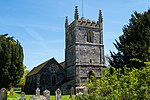River Winterborne

There are two River Winterbornes in Dorset, England.The rivers only flow overground during the winter, hence the name. They both flow through a number of villages with a first name of "Winterborne" or “Winterbourne”. The North Winterborne flows through the following villages in Dorset from its source to the point where it joins the River Stour: Winterborne Houghton Winterborne Stickland Winterborne Clenston Winterborne Whitechurch Winterborne Kingston Winterborne Muston Anderson Winterborne Tomson Winterborne Zelston Almer Sturminster MarshallThe river flows at first southwards and then eastwards. The South Winterborne flows through the following places in Dorset from its source to the point where it joins the River Frome. Winterbourne Abbas Winterbourne Steepleton Winterborne St Martin Winterborne Monkton Winterborne Herringston Winterborne Came
Excerpt from the Wikipedia article River Winterborne (License: CC BY-SA 3.0, Authors, Images).River Winterborne
Stour Valley Way,
Geographical coordinates (GPS) Address Nearby Places Show on map
Geographical coordinates (GPS)
| Latitude | Longitude |
|---|---|
| N 50.8019 ° | E -2.07748 ° |
Address
Stour Valley Way
Stour Valley Way
BH21 4BU , Shapwick
England, United Kingdom
Open on Google Maps










